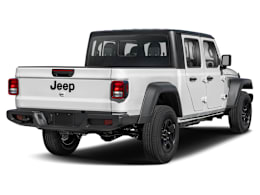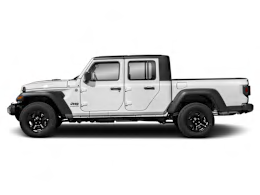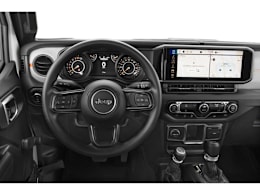The Gladiator transforms the iconic Wrangler into a pickup truck, using a longer wheelbase and adding a 5-foot bed. Not surprisingly, it shares many of the Wrangler's strengths and weaknesses. But where the Wrangler falls short of modern SUV standards, the Gladiator pulls it off as a competitive small truck with a unique character.
The distinction here is that the Gladiator competes in a class dominated by lackluster competitors, and it also has a couple of key advantages. Most significantly, it uses a rear suspension derived from its corporate cousin, the impressive Ram 1500. That gives the Gladiator a better ride than the Wrangler and rivals such as the Ford Ranger and Toyota Tacoma. And the Gladiator carries over Jeep-caliber off-road skills.
The standard 3.6-liter V6 endows the Gladiator has some serious oomph and decent towing capacity. Fuel economy is not stellar, but it is on par with competitors. The 3.0-liter diesel V6 has been dropped for 2024.
Handling is decidedly clumsy with mushy and slow steering that requires a lot of arm work to get the Jeep to turn. It remained under control when pushed to its limits on our track but was completely out of its element.
Getting in and out of the Gladiator is an ungracious affair, due to its tall ride height and wide door sills.
The cabin is relatively large for the class. Drivers sit upright, as in a chair, rather than low to the floor like in General Motors and Toyota compact trucks. But the driving position is adversely affected by the lack of a left foot rest, and constant rubbing against the door’s hinges. The seat is too flat and squishy, and there are no power adjustments.
Some of the controls are cluttered and confusing, and the information within the instrument cluster changes frequently, which can be distracting. It’s easy to get confused as to whether you’re activating regular cruise control or adaptive cruise control via the steering-wheel buttons. There are some inconveniences, like the awkward window controls positioned underneath the center screen--an unfortunate necessity for the ability to remove the doors.
The tailgate is damped, so it lowers slowly--a nice touch.
Like the Wrangler, the Gladiator comes with a soft top or an optional removable hardtop. Owners can take the doors off and fold down the windshield for some pure wind in the hair experience. Even with the hardtop in place, there’s so much wind noise at highway speeds that the truck is best used only for around-town driving.
Off-road enthusiasts might be drawn to the pricey, top-of-the-line Rubicon for its optimized suspension, rear differential, and beefy tires. But all Gladiator trim levels are capable off-road, based on our testing, yet they have no advantage over direct competitors.
Several advanced safety and driver-assist features are available in option packages, including forward collision warning, blind spot warning, rear cross traffic warning, and adaptive cruise control.
The Gladiator is uniquely appealing, with its removable top and doors, rugged design, and good towing capacity. But its shortcomings and hefty price should give shoppers pause, as will the fact that they’ll have to pay extra for key advanced safety features.


























